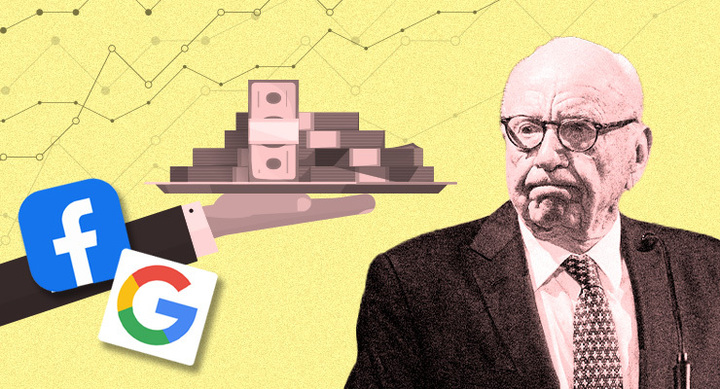
Twelve months on from the Morrison government’s signature legislative achievement — the so-called news media bargaining code — we’re starting to see its impact on Australia’s traditional media: a boost to the corporate bottom line.
Not a bug. A feature. Enough to make the Australian model of forcing big tech to buy off old media go viral — at least in those countries where media has the political clout to force it.
Mired in media attacks over “partygate”, Boris Johnson’s government is still finding time to draft legislation to adopt the Australian approach. It follows official reports that a quarter of Johnson’s meetings with outside organisations in the July-September quarter were with right-wing media, including a “social” meeting with one of the five billionaires who own 80% of British newspapers, American citizen Rupert Murdoch who bunkered down for COVID in the English countryside.
In Canada, the Trudeau government is expected to table similar legislation in Parliament this month after lobbying from its heavily monopolised commercial media.
It’s the political equivalent of Gresham’s law in action: bad policy drives out good, particularly when there’s money to be made.
The UK and Canadian enthusiasm will have been hyped by news at the weekend that the bargaining code is a major driver of the extraordinary profit boost for News Corp. CEO Robert Thomson released its six-monthly end-of-year financial reports last Friday in New York and boasted that “the landmark agreement with big tech continued to benefit our journalism and our bottom line”.
There’s more detail in the official report to the company’s US regulator, the Securities and Exchange Commission, published at the weekend. There it credits the Australian deals based on the code (which it dubs “content licensing revenues”) as the driving force behind the surge in year-on-year revenues in the company’s News Media segment.
Australian masthead revenues were, it said, up by about 14%: “Circulation and subscription revenues increased US$33 million, primarily driven by higher content licensing revenues, digital subscriber growth and … foreign currency fluctuations.” Advertising, too, was up.
The mastheads produce about 40% of News Media’s revenues, and the Australian surge drove its profit (EBITDA) for the first six months of the current year up by A$140 million.
The increased profit also reflects the savings News Corp made as a result of closing most of its regional and community mastheads in May 2020. In the past 30 months it has spent about A$340 million “restructuring” its News Media division, including the Australian closures and the consequent payout to retrenched employees.
There’s less good news in the end-of-year report for its Foxtel division: pay TV subscribers slumped; new streaming services Kayo and Binge lagged competitors like Netflix and Stan; the recently launched Flash news streaming product was too small to report.
Put together, it demonstrates just how important the deals News Corp reached with Meta and Google have been for their Australian footprint and why it and its monopolist colleagues are so eager to take the model offshore.
The legislation passed a year ago required big tech companies fingered by the treasurer (in this case, Meta and Google) to enter into an agreement with major publishers to use their content. After a couple of weeks of boycotts, heated rhetoric and trans-Pacific phone calls between Treasurer Josh Frydenberg and the big tech bosses, dollars were agreed for republishing content, safely sequestered from the danger of anyone actually seeing it in the Google News app and the News tab in Facebook.
The amounts have been kept confidential, but News Corp is understood to be receiving $50 million a year. (New digital media including Crikey and not-for-profit media like Guardian Australia and the ABC have also received some payments. Guardian Australia and the ABC have committed their funding to more local or regional reporting.)
Last week the Google-News Corp relationship went a step further when they announced they were joining to launch the Digital News Academy in the University of Melbourne business school, well away from traditional journalism teaching in the humanities departments. With an expert panel of seven News Corp journalists and three Google representatives (plus academy director Sonja Heydeman), it will focus on digital skills for the company’s journalists, using Google products. (Other smaller companies will be able to participate as well.)
According to the report in The Australian on January 30, the “groundbreaking” course “will develop and enhance the online skills of journalists across the country”.
It’s a win-win for the two US companies. Even as it declines, News Corp will continue to entrench its political and ideological dominance in old media. And as it grows, Google will get tax-deductible brownie points while embedding its product range as the default offering for the media industry.
As reported above, Private Media, the publisher of Crikey, is part of the news bargaining code and has received funding from Google and Meta.








Facebook holds all the cards. If I share an interesting news article, it doesn’t show up in anyone’s feed, facebooks algorithms make sure of it. That means the news that we see is even more limited and more laser focused on our own opinions, rather than broadening horizons like we would wish happened with the news. So the whole thing was detrimental as well as a waste of time and effort and now we see that Murdoch is the beneficiary. What a surprise.